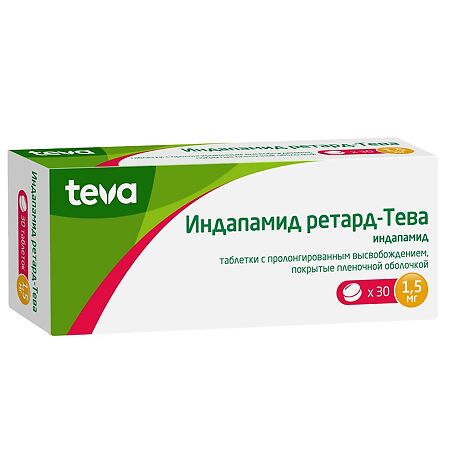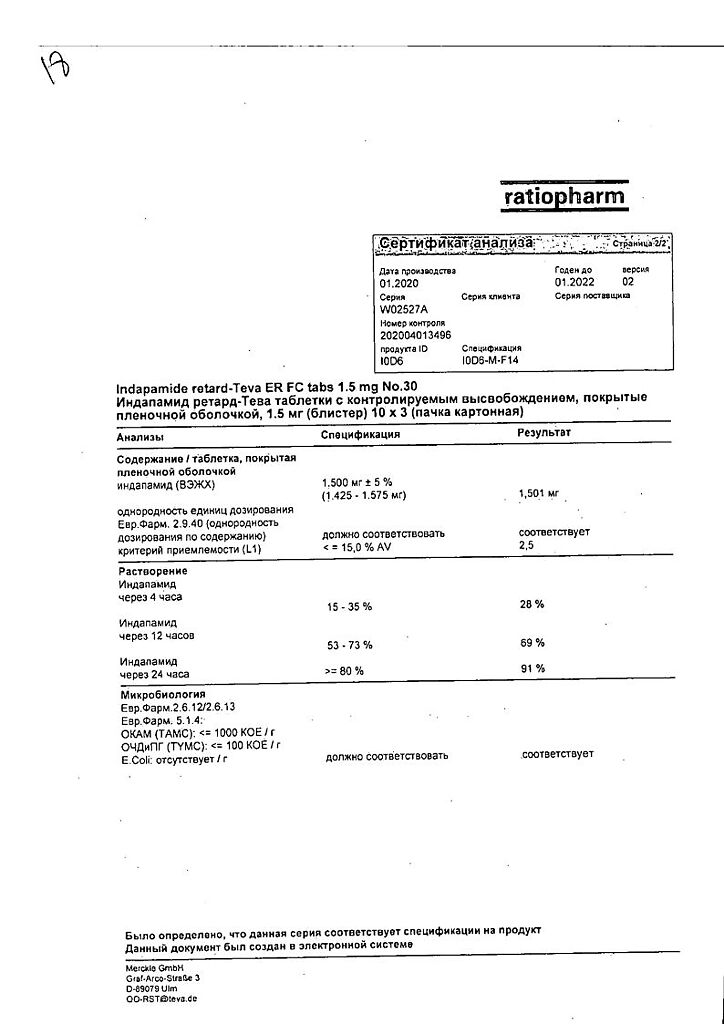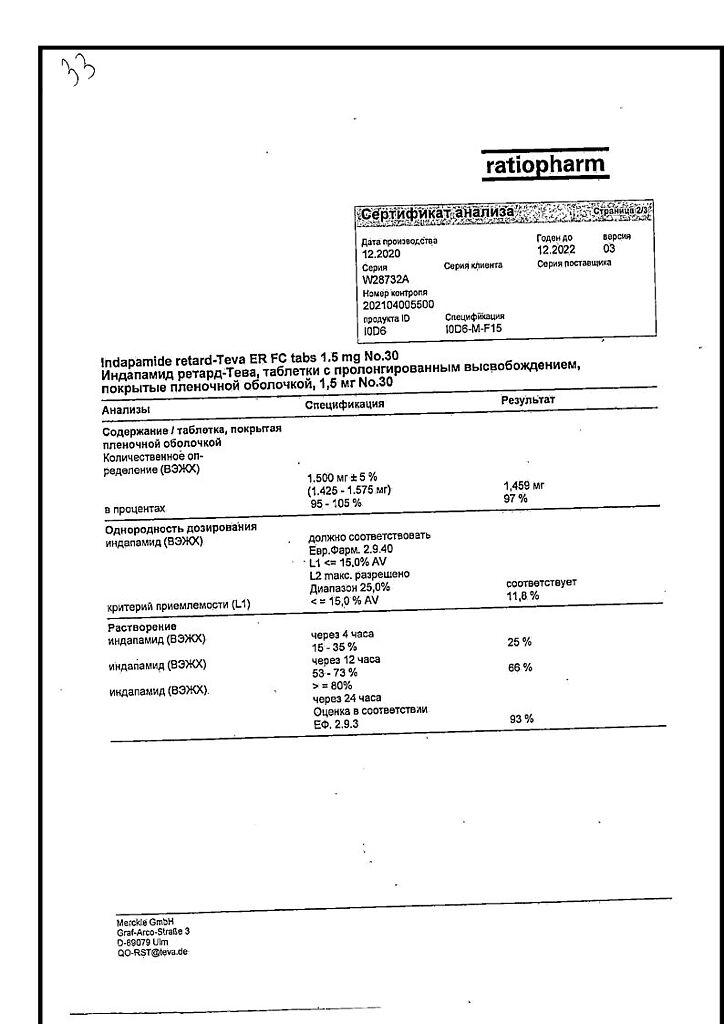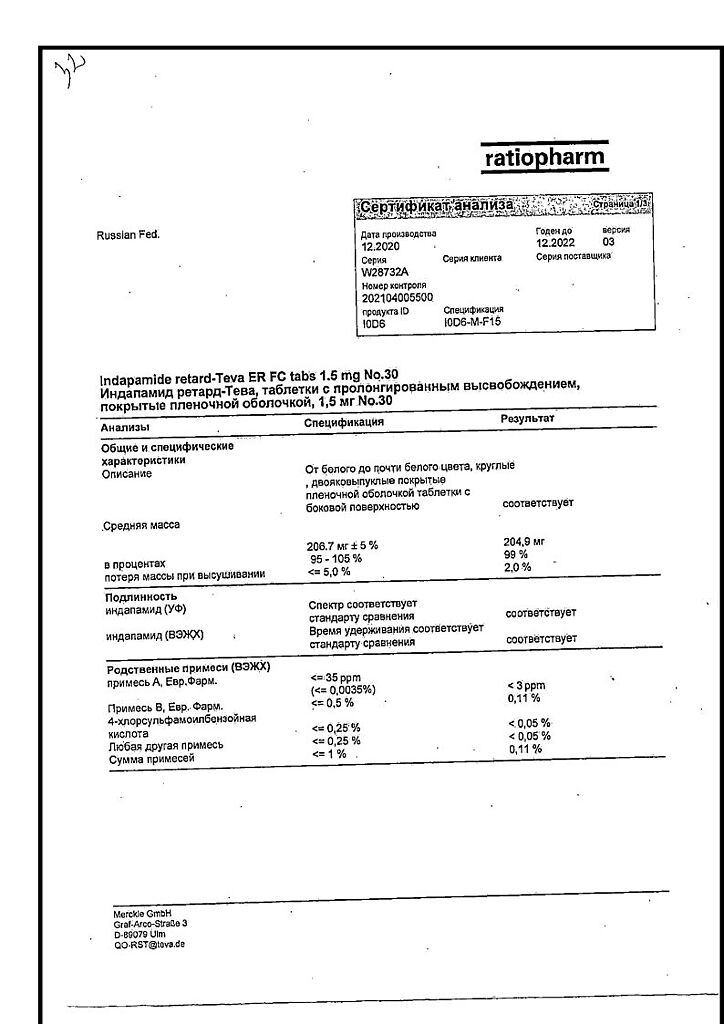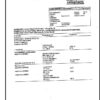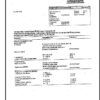No products in the cart.
Indapamide Retard-Teva, 1.5 mg 30 pcs
€3.66 €3.05
Description
Pharmacotherapeutic group: diuretic
ATX code: C03BA11
Pharmacological properties
Pharmacodynamics
Indapamide is a sulfonamide derivative whose structure includes an indole ring.
It is characterized by pharmacological affinity with thiazide diuretics. Indapamide realizes its effects by inhibiting the reabsorption of sodium ions in the distal convoluted tubules. Under the action of indapamide the renal excretion of chlorine ions, sodium ions and, to a lesser extent, excretion of potassium and magnesium is increased, which is accompanied by increased diuresis and antihypertensive effect.
The results of clinical studies have shown that when using indapamide in monotherapy in doses not having significant diuretic effect, a 24-hour hypotensive effect was demonstrated.
The antihypertensive activity of indapamide is associated with improvement of elastic properties of large arteries, reduction of arteriolar and total peripheral vascular resistance.
Tiazide and thiazide-like diuretics at a certain dose are characterized by the formation of a plateau of therapeutic effect, while the severity of adverse effects continues to increase with further increase of the dose. If the desired therapeutic effect cannot be achieved, further dose escalation is not advisable.
In short-, medium-, and long-term studies in patients with arterial hypertension, it has been found that indapamide does not affect lipid metabolism (triglycerides, low-density lipoprotein cholesterol, and high-density lipoprotein cholesterol) and carbohydrate metabolism (including in diabetic patients).
Pharmacokinetics
absorption.
Indapamide is rapidly and completely absorbed from the gastrointestinal (GI) tract. Food intake slightly increases the rate of absorption of indapamide, but has no effect on the completeness of absorption. Maximum plasma concentration of indapamide is reached 12 hours after a single oral dose. Fluctuations in plasma concentration of indapamide are smoothed with repeated doses.
Distribution and metabolism
The binding of indapamide to plasma proteins is 79 %. The equilibrium concentration is reached after 7 days of administration.
There is no cumulation with repeated administration of the drug.
Elimation
Indapamide is excreted primarily by the kidneys (70% of the dose) and through the intestine (22%) in the form of inactive metabolites.
The elimination half-life of indapamide from plasma varies from 14 to 24 hours (mean 18 hours).
In renal failure pharmacokinetic properties of indapamide do not change.
Indications
Indications
Arterial hypertension.
Pharmacological effect
Pharmacological effect
Pharmacotherapeutic group: diuretics; thiazide-like diuretics, sulfonamides
ATX code: S03BA11
Pharmacological properties
Pharmacodynamics
Indapamide is a sulfonamide derivative whose structure includes an indole ring.
It is characterized by pharmacological affinity with thiazide diuretics. Indapamide exerts its effects by inhibiting the reabsorption of sodium ions in the distal convoluted tubule. Under the influence of indapamide, the excretion of chloride and sodium ions by the kidneys increases, as well as, to a lesser extent, the excretion of potassium and magnesium, which is accompanied by an increase in diuresis and an antihypertensive effect.
The results of clinical studies showed that when indapamide was used as monotherapy in doses that did not have a pronounced diuretic effect, a 24-hour hypotensive effect was demonstrated.
The antihypertensive activity of indapamide is associated with an improvement in the elastic properties of large arteries, a decrease in arteriolar and total peripheral vascular resistance.
Indapamide reduces the severity of left ventricular hypertrophy.
Thiazide and thiazide-like diuretics at a certain dose are characterized by the formation of a plateau of therapeutic effect, while the severity of undesirable effects continues to increase with further increases in the dose. If the desired therapeutic effect cannot be achieved, further increasing the dose is not advisable.
In short-term, medium-term and long-term studies in patients with arterial hypertension, it was found that indapamide does not affect lipid metabolism (triglyceride levels, low-density lipoprotein cholesterol and high-density lipoprotein cholesterol) and carbohydrate metabolism (including in patients with diabetes).
Pharmacokinetics
Absorption
The released indapamide is quickly and completely absorbed in the gastrointestinal tract (GIT). Eating slightly increases the absorption time without affecting the completeness of absorption. The maximum concentration in blood plasma is achieved 12 hours after oral administration of a single dose. With repeated doses, fluctuations in the concentration of indapamide in the blood plasma are smoothed out. There is individual variability in absorption rates.
Distribution
The binding of indapamide to plasma proteins is 79%. The half-life of indapamide from blood plasma varies from 14 to 24 hours (average 18 hours). Equilibrium concentration is achieved after 7 days of taking the drug. When taking the drug repeatedly, no accumulation is observed.
Elimination
Indapamide is excreted primarily by the kidneys (70% of the dose) and through the intestines (22%) in the form of inactive metabolites.
Special instructions
Special instructions
Liver dysfunction
When prescribing thiazide and thiazide-like diuretics in patients with impaired liver function, hepatic encephalopathy may develop, especially in the case of electrolyte imbalance. In this case, diuretics should be stopped immediately.
Photosensitivity reactions
While taking thiazide and thiazide-like diuretics, cases of photosensitivity reactions have been reported (see section “Side effects”). If photosensitivity reactions develop while taking the drug, treatment should be discontinued. If it is necessary to continue diuretic therapy, it is recommended to protect the skin from exposure to sunlight or artificial ultraviolet rays.
Water and electrolyte balance
Content of sodium ions in blood plasma
Before starting treatment, it is necessary to determine the content of sodium ions in the blood plasma. While taking the drug, this indicator should be regularly monitored, since initially the decrease in sodium concentration in the blood plasma may be asymptomatic. More frequent monitoring of sodium ion levels is indicated for patients with liver cirrhosis and the elderly (see sections “Side effects” and “Overdose”).
All diuretic drugs can cause hyponatremia, sometimes leading to extremely serious consequences. Hyponatremia and hypovolemia can lead to dehydration and orthostatic hypotension. A concomitant decrease in the concentration of chloride ions can lead to secondary compensatory metabolic alkalosis; the frequency and severity of this effect are insignificant.
Content of potassium ions in blood plasma
When treating with thiazide and thiazide-like diuretics, the main risk is a decrease in the concentration of potassium in the blood plasma and the development of hypokalemia. It is necessary to prevent the risk of developing hypokalemia (<3.4 mmol/l) in patients at high risk in the following categories: elderly, debilitated and/or receiving concomitant drug therapy, patients with liver cirrhosis, peripheral edema and ascites, patients with coronary heart disease, heart failure. Hypokalemia in these patients increases the toxic effect of cardiac glycosides and increases the risk of developing arrhythmias.
In addition, patients with an increased QT interval, both congenital and drug-induced, are at increased risk.
Hypokalemia, like bradycardia, is a condition that contributes to the development of severe arrhythmias and, especially, tachycardia of the “pirouette” type, which can be fatal.
In all the cases described above, it is necessary to regularly monitor the concentration of potassium in the blood plasma. The first measurement of the concentration of potassium ions in the blood must be carried out within the first week from the start of treatment.
If hypokalemia occurs, appropriate treatment should be prescribed.
Calcium content in blood plasma
It should be borne in mind that thiazide and thiazide-like diuretics can reduce the excretion of calcium ions by the kidneys, leading to a slight and temporary increase in the concentration of calcium in the blood plasma. Severe hypercalcemia may be a consequence of previously undiagnosed hyperparathyroidism.
Diuretics should be discontinued before testing parathyroid function.
Plasma glucose levels
It is necessary to monitor plasma glucose levels in patients with diabetes mellitus, especially in the presence of hypokalemia.
Uric acid
In patients with gout, the frequency of attacks may increase or the course of gout may worsen.
Diuretics and kidney function
Thiazide and thiazide-like diuretics are fully effective only in patients with normal or slightly impaired renal function (plasma creatinine in adults below 25 mg/l or 220 µmol/l). In elderly patients, normal plasma creatinine levels are calculated taking into account age, body weight and gender.
It should be taken into account that at the beginning of treatment, patients may experience a decrease in glomerular filtration rate due to hypovolemia, which, in turn, is caused by the loss of fluid and sodium ions while taking diuretic drugs. As a result, the concentration of urea and creatinine in the blood plasma may increase. If renal function is not impaired, such temporary functional renal failure, as a rule, passes without consequences, however, with existing renal failure, the patient’s condition may worsen.
Athletes
Indapamide may give a positive result during doping control in athletes.
Choroidal effusion, acute myopia and secondary angle-closure glaucoma
Sulfonamide and its derivatives can cause an idiosyncratic reaction, leading to the development of choroidal effusion with visual field impairment, acute transient myopia and an acute attack of angle-closure glaucoma. Symptoms include acute loss of visual acuity or eye pain and usually occur within a few hours to several weeks after starting the drug. If left untreated, acute angle-closure glaucoma can lead to permanent vision loss. First of all, it is necessary to stop taking the drug as quickly as possible. If intraocular pressure remains uncontrolled, emergency medical treatment or surgery may be required. Risk factors for the development of an acute attack of angle-closure glaucoma are a history of allergic reactions to sulfonamide derivatives or penicillin.
Excipients
The drug Indapamide retard-Teva contains lactose monohydrate. Patients with rare hereditary diseases such as galactose intolerance, lactose intolerance due to lactase deficiency, or glucose-galactose malabsorption syndrome should not take this drug.
Impact on the ability to drive vehicles and machinery
The effect of the substances included in the drug Indapamide retard-Teva does not lead to impairment of attention. However, some people may develop different reactions in response to lowering blood pressure, especially at the beginning of therapy or when other antihypertensive drugs are added to their therapy. In this case, the ability to drive a car or operate other machinery may be impaired.
Active ingredient
Active ingredient
Indapamide
Composition
Composition
1 tablet contains the active ingredient: indapamide 1.50 mg; excipients: lactose monohydrate 119.10 mg, hypromellose 77.40 mg, colloidal silicon dioxide 1.00 mg, magnesium stearate 1.00 mg; shell: hypromellose 5.00 mg, glycerol 85% 0.70 mg, titanium dioxide 1.00 mg.
Pregnancy
Pregnancy
Pregnancy
There is currently insufficient data on the use of indapamide during pregnancy (less than 300 cases have been described).
Long-term use of thiazide diuretics in the third trimester of pregnancy can cause hypovolemia in the mother and a decrease in uteroplacental blood flow, which leads to delayed fetal development.
Animal studies have shown no direct or indirect effects on pregnancy.
The use of indapamide should be avoided during pregnancy.
Breastfeeding period
Indapamide or its metabolites passes into breast milk. The newborn may develop hypersensitivity to sulfonamide derivatives and hypokalemia. Therefore, a risk to the newborn/infant cannot be excluded. Indapamide is close to thiazide diuretics, the use of which causes a decrease in the amount of breast milk or even suppression of lactation.
Indapamide should not be used during breastfeeding.
Fertility
Preclinical studies have shown no effects on reproductive function in rats of both sexes. Presumably there is no effect on human fertility.
Contraindications
Contraindications
• Hypersensitivity to indapamide, other sulfonamide derivatives or to any of the excipients.
• Severe renal failure (creatinine clearance (CC) less than 30 ml/min).
• Severe liver failure or hepatic encephalopathy.
• Hypokalemia.
• Due to the fact that the drug contains lactose, Indapamide retard-Teva is not recommended for patients with lactose intolerance, galactosemia, glucose-galactose malabsorption.
• Pregnancy and breastfeeding.
• Age under 18 years (efficacy and safety have not been established).
With caution
Mild or moderate liver and kidney disorders, fluid and electrolyte imbalance, use in patients with a prolonged QT interval on ECG, peripheral edema or ascites, coronary artery disease, heart failure, hyperparathyroidism, diabetes mellitus, hyperuricemia and gout, history of allergic reaction to penicillin, use in debilitated patients receiving concomitant therapy with drugs that can prolong the interval QT, use with drugs that can cause polymorphic ventricular tachycardia of the torsade de pointes type, lithium drugs, drugs that can cause hypokalemia or with cardiac glycosides.
Side Effects
Side Effects
Security Profile Summary
The most common adverse reactions reported were hypersensitivity reactions, mainly dermatological, in patients with a predisposition to allergic and asthmatic reactions, and maculopapular rash.
In clinical studies, hypokalemia (potassium concentration less than 3.4 mmol/L) was observed in 10% of patients, and potassium concentration less than 3.2 mmol/L was observed in 4% of patients 4-6 weeks after the start of therapy.
After 12 weeks of therapy, the mean decrease in plasma potassium concentration was 0.23 mmol/L.
Most adverse reactions (laboratory and clinical indicators) are dose-dependent.
Tabular summary of adverse reactions
The frequency of adverse reactions that were noted during indapamide therapy is given in the following gradation: very often (≥ 1/10); often (from ≥ 1/100 to < 1/10); uncommon (≥ 1/1000 to < 1/100), rare (≥ 1/10,000 to < 1/1000), very rare (< 1/10,000), unknown (frequency cannot be calculated from available data).
Classes and organ systems
Adverse reactions
Frequency
Blood and lymphatic system disorders
Agranulocytosis
Very rarely
Aplastic anemia
Very rarely
Hemolytic anemia
Very rarely
Leukopenia
Very rarely
Thrombocytopenia
Very rarely
Metabolic and nutritional disorders
Hypercalcemia
Very rarely
A decrease in potassium concentration and the development of hypokalemia, especially significant for patients at risk
Frequency unknown
Hyponatremia
Frequency unknown
Nervous system disorders
Vertigo
Rarely
Increased fatigue
Rarely
Headache
Rarely
Paresthesia
Rarely
Fainting
Frequency unknown
Visual disorders
Myopia
Frequency unknown
Blurred vision
Frequency unknown
Visual impairment
Frequency unknown
Choroidal effusion
Frequency unknown
Heart disorders
Arrhythmia
Very rarely
Polymorphic ventricular tachycardia type “pirouette” (potentially fatal)
Frequency unknown
Vascular disorders
Arterial hypotension
Very rarely
Gastrointestinal disorders
Vomit
Uncommon
Nausea
Rarely
Constipation
Rarely
Dry mouth
Rarely
Pancreatitis
Very rarely
Disorders of the liver and biliary tract
Liver dysfunction
Very rarely
Possible development of hepatic encephalopathy in case of liver failure
Frequency unknown
Hepatitis
Frequency unknown
Skin and subcutaneous tissue disorders
Hypersensitivity reactions
Often
Maculopapular rash
Often
Purpura
Uncommon
Angioedema
Very rarely
Hives
Very rarely
Toxic epidermal necrolysis
Very rarely
Stevens-Johnson syndrome
Very rarely
Possible exacerbation of existing acute systemic lupus erythematosus
Frequency unknown
Photosensitivity reactions
Frequency unknown
Renal and urinary tract disorders
Kidney failure
Very rarely
Deviation from normal laboratory tests
indicators and survey results
Prolongation of the QT interval on the ECG
Frequency unknown
Increased blood glucose concentration
Frequency unknown
Increased uric acid concentration
Frequency unknown
Increased liver enzyme activity
Frequency unknown
Interaction
Interaction
Combinations not recommended for use
Lithium preparations
With the simultaneous use of indapamide and lithium preparations, as well as when following a salt-free diet, an increase in the concentration of lithium in the blood plasma may be observed due to a decrease in its excretion, accompanied by signs of overdose. If necessary, diuretics can be used with lithium preparations, and the lithium content in the blood plasma should be carefully monitored and the dose of the drug should be adjusted accordingly.
Combinations requiring precautions
Drugs that can cause polymorphic ventricular tachycardia of the torsade de pointes type
– class IA antiarrhythmic drugs (quinidine, hydroquinidine, disopyramide, procainamide) and class IC (flecainide);
– class III antiarrhythmic drugs (amiodarone, sotalol, dofetilide, ibutilide, bretylium tosylate, dronedarone);
– neuroleptics: phenothiazines (chlorpromazine, cyamemazine, levomepromazine, thioridazine, trifluoperazine, fluphenazine), benzamides (amisulpride, sulpiride, sultopride, tiapride), butyrophenones (droperidol, haloperidol), pimozide, sertindole;
– antidepressants: tricyclic antidepressants, selective serotonin reuptake inhibitors (citalopram, escitalopram);
– antibacterial agents: fluoroquinolones (levofloxacin, moxifloxacin, sparfloxacin, ciprofloxacin); macrolides (erythromycin for intravenous use, azithromycin, clarithromycin, roxithromycin, spiramycin), co-trimoxazole;
– antifungal agents of a number of azoles (voriconazole, itraconazole, ketoconazole, fluconazole);
– antimalarials (quinine, chloroquine, mefloquine, halofantrine, lumefantrine);
– antianginal drugs (ranolazine, bepridil);
– antitumor drugs and immunosuppressants (vandetanib, arsenic trioxide, oxaliplatin, tacrolimus, anagrelide);
– antiemetics (ondansetron);
– drugs that affect gastrointestinal motility (cisapride, domperidone);
– antihistamines (astemizole, terfenadine, anagrelide);
– others: pentamidine, diphemanil, vincamine for intravenous use, vasopressin, terlipressin, ketanserin, probucol, propofol, sevoflurane, terodiline, cilostazol.
Increased risk of developing ventricular arrhythmias, in particular polymorphic ventricular tachycardia of the “pirouette” type (risk factor – hypokalemia). Before starting combination therapy with indapamide and the above drugs, a study should be conducted to identify hypokalemia and, if necessary, correct it. It is necessary to monitor the patient’s clinical condition, the level of electrolytes in the blood plasma and ECG parameters.
In patients with hypokalemia, it is necessary to use drugs that do not cause polymorphic ventricular tachycardia of the “pirouette” type.
Nonsteroidal anti-inflammatory drugs (intended for systemic use), including selective cyclooxygenase-2 (COX-2) inhibitors and high doses of acetylsalicylic acid (more than 3 g/day)
The antihypertensive effect of indapamide may be reduced. Dehydrated patients are at risk of developing acute renal failure due to decreased glomerular filtration rate. Patients need to compensate for fluid loss and carefully monitor renal function at the beginning of therapy.
Angiotensin-converting enzyme (ACE) inhibitors
Prescribing ACE inhibitors against the background of sodium deficiency (especially in patients with renal artery stenosis) is accompanied by the risk of developing sudden arterial hypotension and/or acute renal failure.
Patients with arterial hypertension and possibly reduced levels of sodium ions in the blood plasma due to diuretics should:
– 3 days before starting treatment with an ACE inhibitor, stop taking the diuretic. In the future, if necessary, the use of a non-potassium-sparing diuretic can be resumed;
– or start ACE inhibitor therapy with low doses, followed by a gradual increase in dose if necessary.
In chronic heart failure, treatment with ACE inhibitors should begin with the lowest doses, with a possible preliminary reduction in the dose of a non-potassium-sparing diuretic.
In all cases, in the first weeks of taking ACE inhibitors in patients, it is necessary to monitor renal function (plasma creatinine content).
Other drugs that can cause hypokalemia (amphotericin B for intravenous use, glucocorticosteroids, mineralocorticosteroids for systemic use, tetracosactide, laxatives that stimulate intestinal motility)
The risk of developing hypokalemia increases (additive effect).
Constant monitoring of the concentration of potassium in the blood plasma is necessary, and, if necessary, its correction. Particular attention should be paid to patients concomitantly receiving cardiac glycosides. It is recommended to use laxatives that do not stimulate intestinal motility.
Baclofen
There is an increase in the hypotensive effect of indapamide.
Patients need to compensate for fluid loss and carefully monitor renal function at the beginning of treatment.
Cardiac glycosides
Hypokalemia enhances the toxic effect of cardiac glycosides. With the simultaneous use of indapamide and cardiac glycosides, the concentration of potassium in the blood plasma, ECG readings should be monitored, and, if necessary, therapy should be adjusted.
Combinations requiring special attention
Allopurinol
Concomitant use with indapamide may increase the risk of hypersensitivity reactions during treatment with allopurinol.
Combinations that require attention
Potassium-sparing diuretics (amiloride, spironolactone, triamterene)
Combination therapy with indapamide and potassium-sparing diuretics is advisable in some patients, but the possibility of developing hypokalemia or hyperkalemia cannot be excluded (especially in patients with renal failure and/or diabetes mellitus). In this case, the concentration of potassium in the blood plasma, ECG indicators should be monitored, and, if necessary, therapy should be adjusted.
Metformin
Functional renal failure, which can occur while taking diuretics, especially loop diuretics, with simultaneous administration of metformin increases the risk of developing lactic acidosis.
Metformin should not be used if the plasma creatinine concentration exceeds 15 mg/l (135 µmol/l) in men and 12 mg/l (110 µmol/l) in women.
Iodinated contrast agents
Against the background of dehydration caused by diuretics, there is an increased risk of developing acute renal failure, especially with the concomitant use of iodinated contrast agents in high doses.
Before prescribing iodinated contrast agents, patients must be compensated for fluid loss.
Tricyclic antidepressants, antipsychotics (neuroleptics)
Drugs in these classes enhance the antihypertensive effect of indapamide and increase the risk of orthostatic hypotension (additive effect).
Calcium salts
With simultaneous administration, hypercalcemia may develop due to a decrease in the excretion of calcium ions by the kidneys.
Cyclosporine, tacrolimus
It is possible to increase the creatinine content in the blood plasma without changing the concentration of circulating cyclosporine, even with normal fluid and sodium ion levels.
Corticosteroid drugs, tetracosactide (if administered systemically)
Reducing the hypotensive effect of indapamide (corticosteroids cause fluid and sodium retention in the body).
Overdose
Overdose
Symptoms
Indapamide, even in very high doses (up to 40 mg, i.e. 27 times more than the therapeutic dose), does not have a toxic effect.
Signs of acute drug poisoning are primarily associated with water and electrolyte imbalance (hyponatremia, hypokalemia). Clinical symptoms of overdose may include: nausea, vomiting, decreased blood pressure, convulsions, vertigo, drowsiness, confusion, polyuria or oliguria with possible transition to anuria (due to hypovolemia).
Treatment
Emergency measures are limited to removing the drug from the body: gastric lavage and/or administration of activated charcoal, followed by restoration of water and electrolyte balance.
Storage conditions
Storage conditions
Store at a temperature not exceeding 25 °C.
Keep out of the reach of children.
Shelf life
Shelf life
2 years.
Do not use after expiration date.
Manufacturer
Manufacturer
Merkle GmbH, Germany
Additional information
| Shelf life | 2 years. Do not use after the expiration date. |
|---|---|
| Conditions of storage | Store at a temperature not exceeding 25 °C. Keep out of the reach of children. |
| Manufacturer | Merkle GmbH, Germany |
| Medication form | sustained release tablets |
| Brand | Merkle GmbH |
Related products
Buy Indapamide Retard-Teva, 1.5 mg 30 pcs with delivery to USA, UK, Europe and over 120 other countries.

